Abstract
In 66 untreated patients with hyperthyroidism, serum triiodothyronine (T3) and thyroxine (T4) concentrations were measured by immunoassay. The mean T3 level was 478±28 ng/100 ml (all values mean±SEM) and the T4 was 20.6±0.6 μg/100 ml. The serum T4/T3 ratio by weight was 48±2 as opposed to a value of 71±3 in euthyroid adults. There was a significant inverse correlation of the T4/T3 ratios with serum T3 (r=0.77; P<0.01) but not with serum T4(r=0.21). These results suggested that relative overproduction of T3 is consistently present in patients with hyperthyroidism.
To examine the acute effects of various antithyroid agents on serum T3 and T4 concentrations, iodide, propylthiouracil (PTU), and methylmercaptoimidazole (MMI) were given alone to mine patients, and serial T3 and T4 measurements were made. There was an acute decrease in serum T3 over the first 5 days in the three iodide and three PTU-treated patients which was greater than that seen in the MMI group. This suggested that PTU and MMI had different effects on T3 production.
To compare the effects of PTU and MMI under conditions in which thyroidal hormone release was minimized, these drugs were given in combination with iodide. The mean daily dosage of PTU was 827 (n=11) and of MMI was 88 (n=8). In the PTU+iodide group, the initial serum T3 concentration was 586±61 ng/100 ml and decreased significantly to 326±41 on day 1 and to 248±21 on days 2 and 3, respectively, and did not change further on days 4 and 5. In the MMI + iodide group, basal serum T3 was 645±90 ng/100 ml and decreased to 568±81, 452±73, and 344±51 on days 1, 2, and 3, respectively, and did not change thereafter. While the initial T3 concentrations in serum were not different in the PTU and MMI groups, the T3 concentrations in the PTU patients were significantly lower on days 1 and 2 and during the apparent plateau period on days 3-5. Serum T4 concentrations decreased gradually in both groups, from 23.9±2.0 μg/100 ml, initially, to 17.5±1.6 on day 5 in the PTU group and from 22.0±2.6 to 14.6±2.0 in the MMI-treated patients. The T4 values were not significantly different at any time. These changes resulted in increases in the serum T4/T3 ratios in both groups, but these ratios were substantially higher in the patients treated with PTU + iodide. The initial serum T4/T3 ratio was 43±3 and increased to 74±7 and 88±7 on days 1 and 2 in the PTU group, reaching a plateau value of 91±7 during days 3-5. Comparable values for MMI-treated patients were 35±2, 42±3, 52±6, and 54±3 during the plateau period.
Previous investigations have shown that PTU inhibits T4 deiodination in hyperthyroid patients and decreases T3 production from T4 in animals. The greater acute decrease in serum T3 and the higher serum T4/T3 ratios in the PTU-treated patients seems best explained by an inhibition of peripheral T3 production by this agent. This conclusion is further supported by a direct relationship between the T4/T3 ratio on days 3-5 and the dose of PTU administered. These results further suggest that both thyroidal and extrathyroidal pathways contribute substantially to the apparent overproduction of T3 in hyperthyroidism.
Full text
PDF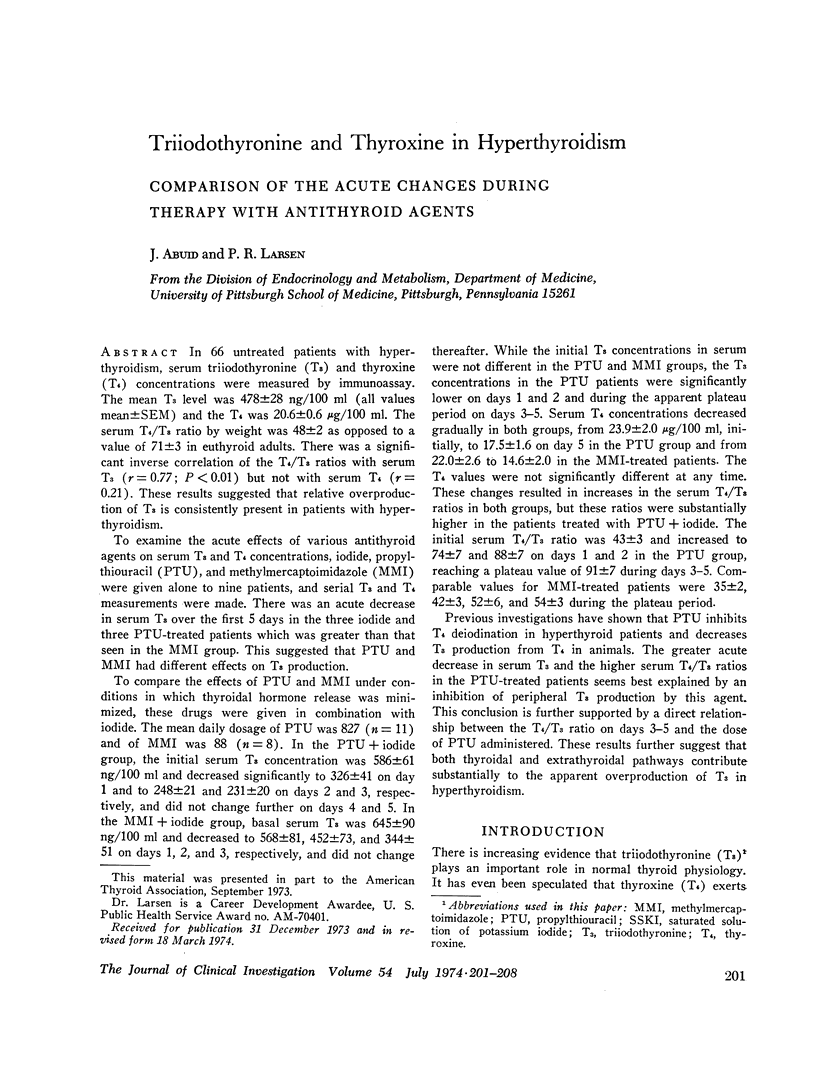
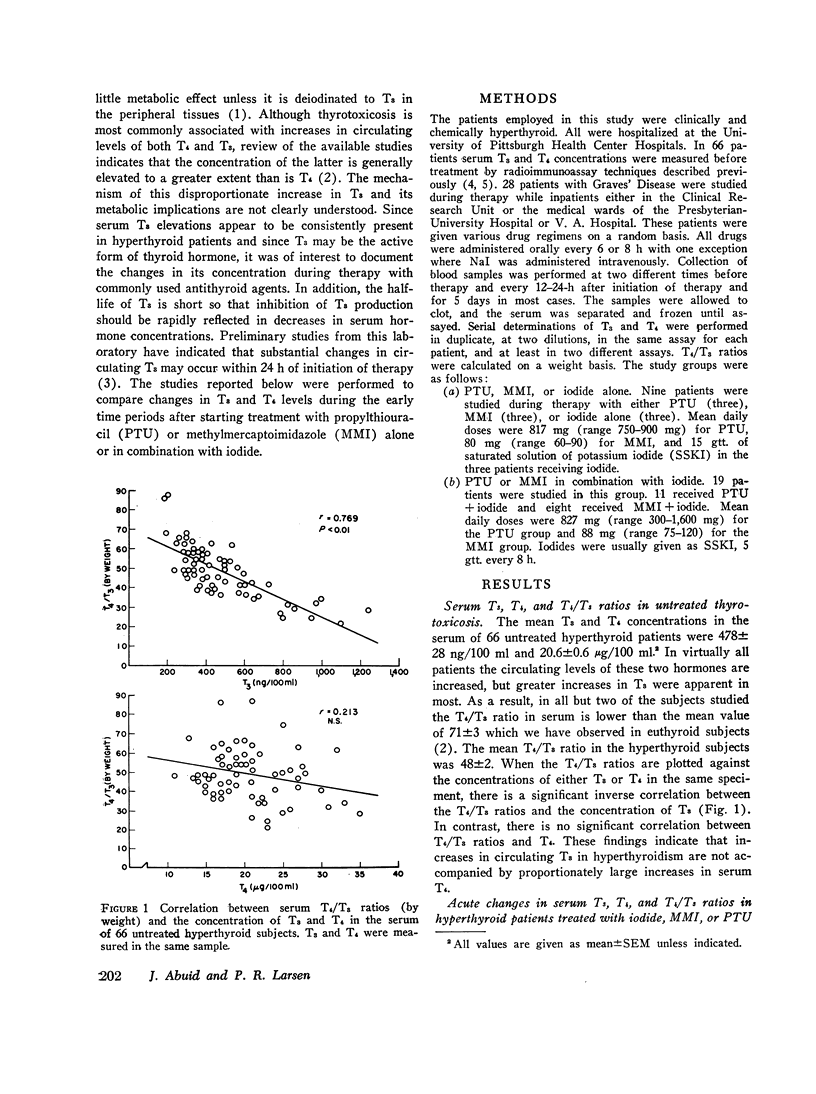
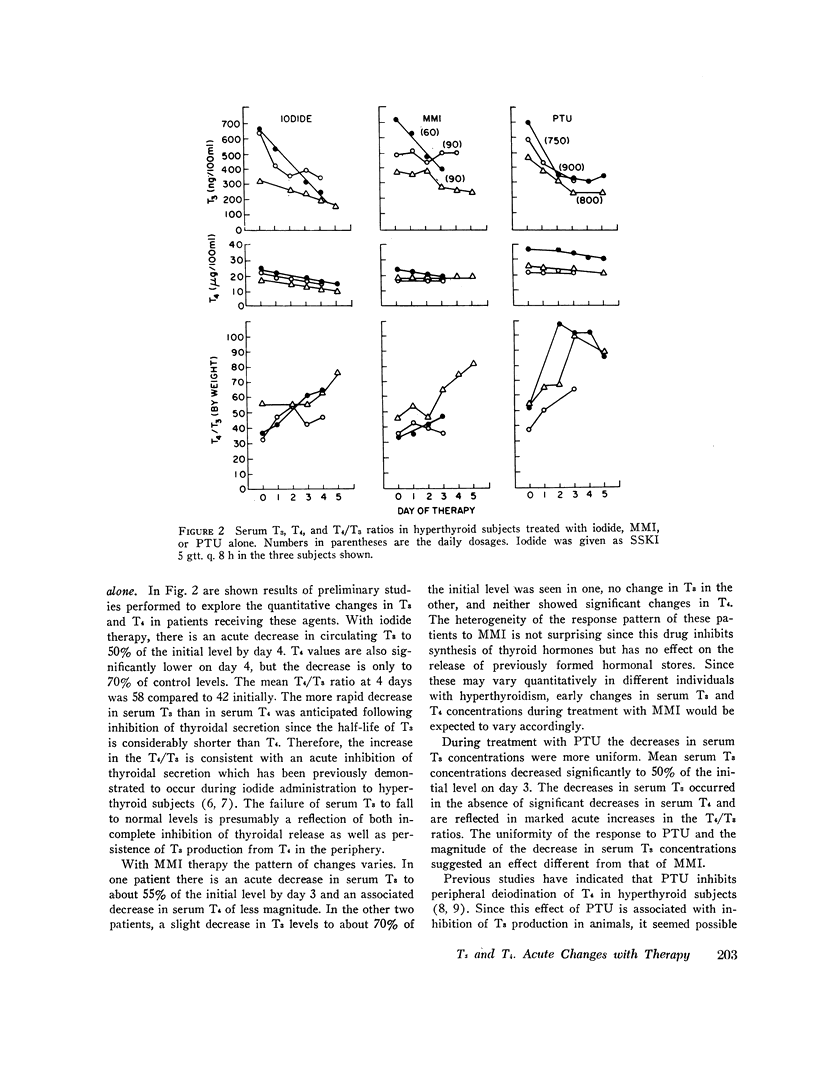
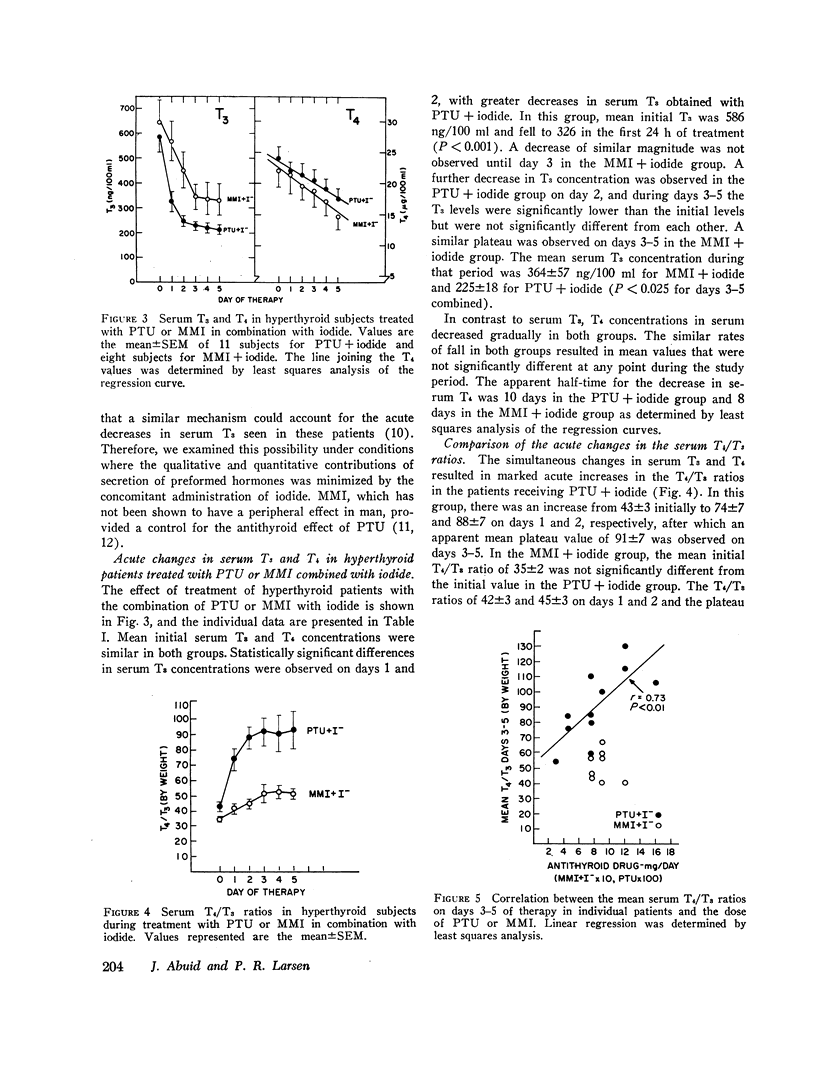
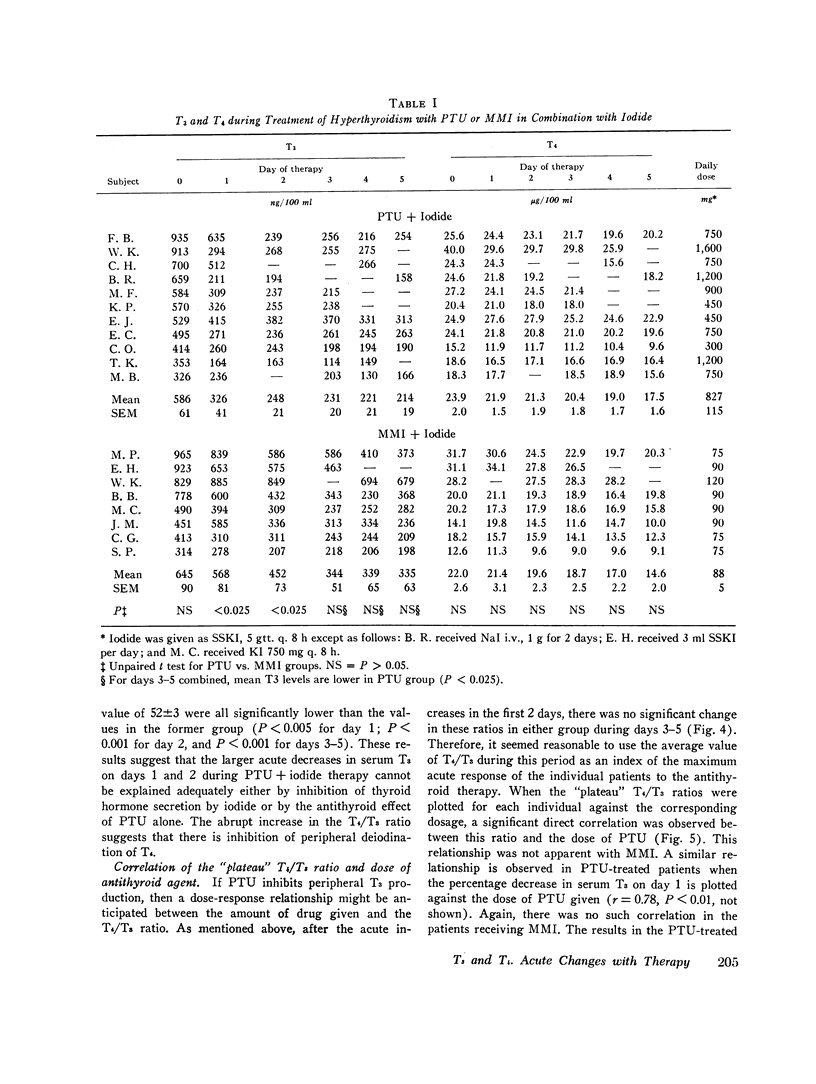
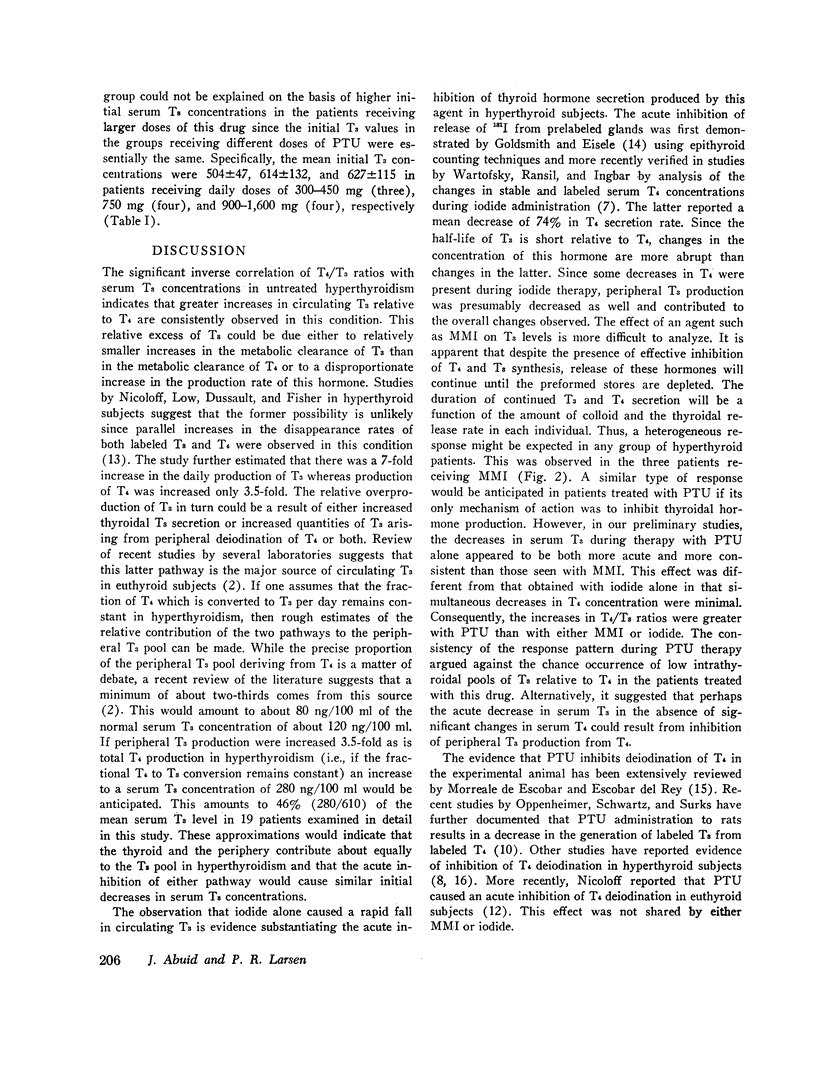
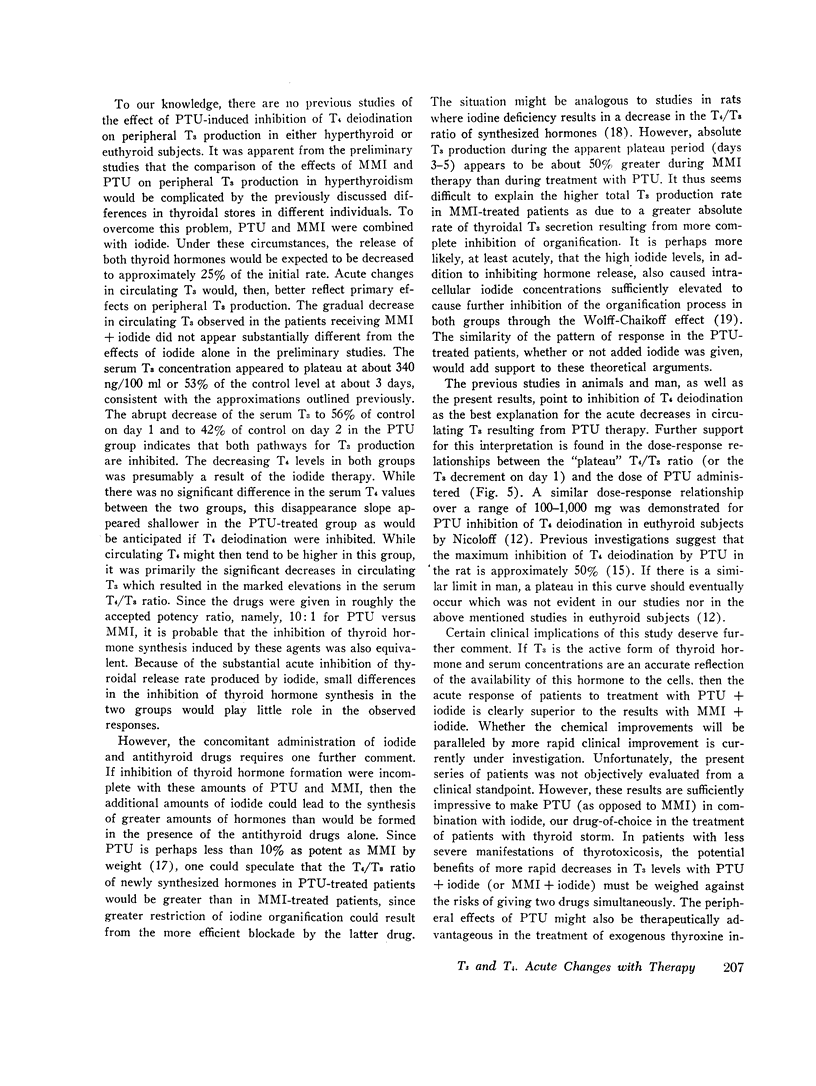
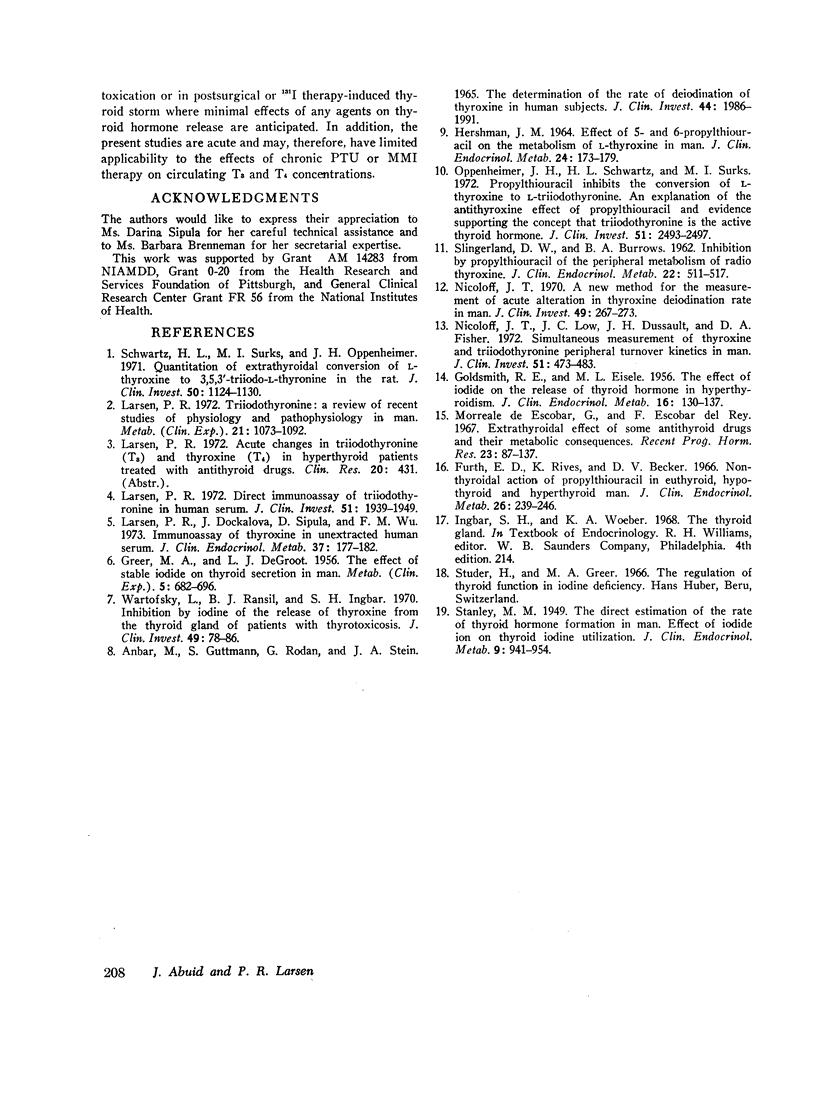
Selected References
These references are in PubMed. This may not be the complete list of references from this article.
- Anbar M., Guttmann S., Rodan G., Stein J. A. The determination of the rate of deiodination of thyroxine in human subjects. J Clin Invest. 1965 Dec;44(12):1986–1991. doi: 10.1172/JCI105305. [DOI] [PMC free article] [PubMed] [Google Scholar]
- DEGROOT L. J., GREER M. A. The effect of stable iodide on thyroid secretion in man. Metabolism. 1956 Nov;5(6 Pt 1):682–696. [PubMed] [Google Scholar]
- Furth E. D., Rives K., Becker D. V. Nonthyroidal action of propylthiouracil in euthyroid, hypothyroid and hyperthyroid man. J Clin Endocrinol Metab. 1966 Mar;26(3):239–246. doi: 10.1210/jcem-26-3-239. [DOI] [PubMed] [Google Scholar]
- GOLDSMITH R. E., EISELE M. L. The effect of iodide on the release of thyroid hormone in hyperthyroidism. J Clin Endocrinol Metab. 1956 Jan;16(1):130–137. doi: 10.1210/jcem-16-1-130. [DOI] [PubMed] [Google Scholar]
- HERSHMAN J. M. EFFECT OF 5- AND 6-PROPYLTHIOURACIL ON THE METABOLISM OF L-THYROXINE IN MAN. J Clin Endocrinol Metab. 1964 Feb;24:173–179. doi: 10.1210/jcem-24-2-173. [DOI] [PubMed] [Google Scholar]
- Larsen P. R. Direct immunoassay of triiodothyronine in human serum. J Clin Invest. 1972 Aug;51(8):1939–1949. doi: 10.1172/JCI107000. [DOI] [PMC free article] [PubMed] [Google Scholar]
- Larsen P. R., Dockalova J., Sipula D., Wu F. M. Immunoassay of thyroxine in unextracted human serum. J Clin Endocrinol Metab. 1973 Aug;37(2):177–182. doi: 10.1210/jcem-37-2-177. [DOI] [PubMed] [Google Scholar]
- Larsen P. R. Triiodothyronine: review of recent studies of its physiology and pathophysiology in man. Metabolism. 1972 Nov;21(11):1073–1092. doi: 10.1016/0026-0495(72)90038-8. [DOI] [PubMed] [Google Scholar]
- Morreale de Escobar G., Escobar del Rey F. Extrathyroid effects of some antithyroid drugs and their metabolic consequences. Recent Prog Horm Res. 1967;23:87–137. doi: 10.1016/b978-1-4831-9826-2.50006-4. [DOI] [PubMed] [Google Scholar]
- Nicoloff J. T. A new method for the measurement of acute alterations in thyroxine deiodination rate in man. J Clin Invest. 1970 Feb;49(2):267–273. doi: 10.1172/JCI106236. [DOI] [PMC free article] [PubMed] [Google Scholar]
- Nicoloff J. T., Low J. C., Dussault J. H., Fisher D. A. Simultaneous measurement of thyroxine and triiodothyronine peripheral turnover kinetics in man. J Clin Invest. 1972 Mar;51(3):473–483. doi: 10.1172/JCI106835. [DOI] [PMC free article] [PubMed] [Google Scholar]
- Oppenheimer J. H., Schwartz H. L., Surks M. I. Propylthiouracil inhibits the conversion of L-thyroxine to L-triiodothyronine. An explanation of the antithyroxine effect of propylthiouracil and evidence supporting the concept that triiodothyronine is the active thyroid hormone. J Clin Invest. 1972 Sep;51(9):2493–2497. doi: 10.1172/JCI107063. [DOI] [PMC free article] [PubMed] [Google Scholar]
- SLINGERLAND D. W., BURROWS B. A. Inhibition by propylthiouracil of the peripheral metabolism of radiothyroxine. J Clin Endocrinol Metab. 1962 May;22:511–517. doi: 10.1210/jcem-22-5-511. [DOI] [PubMed] [Google Scholar]
- Schwartz H. L., Surks M. I., Oppenheimer J. H. Quantitation of extrathyroidal conversion of L-thyroxine to 3,5,3'-triiodo-L-thyronine in the rat. J Clin Invest. 1971 May;50(5):1124–1130. doi: 10.1172/JCI106584. [DOI] [PMC free article] [PubMed] [Google Scholar]
- Wartofsky L., Ransil B. J., Ingbar S. H. Inhibition by iodine of the release of thyroxine from the thyroid glands of patients with thyrotoxicosis. J Clin Invest. 1970 Jan;49(1):78–86. doi: 10.1172/JCI106225. [DOI] [PMC free article] [PubMed] [Google Scholar]


